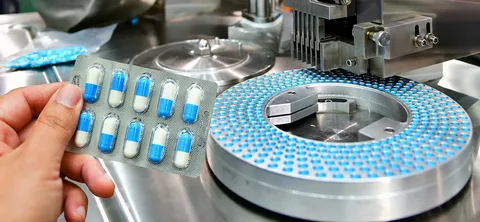Capsules are one of the most common forms of oral medication, offering easy swallowing, precise dosing, and protection for sensitive ingredients. Behind the scenes, capsule filling equipment plays a vital role in the pharmaceutical industry, automating the production of millions of capsules daily for both prescription and over-the-counter drugs.
From small-scale research labs to large commercial facilities, capsule filling machines help pharmaceutical companies meet strict standards of accuracy, consistency, and regulatory compliance. In this article, we’ll explore the key types of capsule filling equipment, how they work, and why they’re essential in modern drug manufacturing.
What is Capsule Filling Equipment?
Capsule filling equipment is machinery used to fill empty gelatin or HPMC capsules with pharmaceutical substances—usually powders, pellets, granules, or liquids. These machines can be manual, semi-automatic, or fully automatic, depending on production scale and speed requirements.
The goal is to ensure that every capsule contains a consistent and accurate dose of medication, while minimizing product loss, contamination, and variability.
Types of Capsule Filling Machines
The pharmaceutical industry uses different types of capsule filling machines based on batch size, formulation, and production needs.
1. Manual Capsule Fillers
- Ideal for small-scale production or research labs
- Low output (hundreds to a few thousand capsules/hour)
- Operators manually load powders and capsules
- Cost-effective but labor-intensive
2. Semi-Automatic Capsule Fillers
- Used in mid-sized operations
- Capsule separation, filling, and closing involve some automation
- Output of 10,000–25,000 capsules/hour
- Requires some manual supervision but offers better speed and consistency
3. Fully Automatic Capsule Fillers
- Standard in large pharmaceutical production facilities
- Complete automation: capsule feeding, separation, filling, locking, and discharge
- Output ranges from 50,000 to 200,000+ capsules/hour
- High precision, suitable for mass production and complex drug formulations
Capsule Filling Methods
The filling technique depends on the form of the drug being encapsulated:
- Powder Filling: Most common; uses tamping or dosator methods
- Pellet Filling: Allows time-release or multi-dose medications
- Granule Filling: Useful for combining active and inert ingredients
- Liquid and Oil-Based Filling: Requires specialized equipment to seal capsules post-filling
Each method must maintain dose accuracy, flowability, and moisture control to ensure product quality.
Key Components of Capsule Filling Machines
Though machine design may vary, most capsule fillers include:
- Capsule hopper – Holds empty capsules for feeding
- Orientation station – Aligns capsule bodies and caps
- Filling station – Dispenses the correct dosage into the body
- Closing station – Joins the cap and body securely
- Ejection system – Removes finished capsules for inspection or packaging
Advanced machines may also include features like:
- Vacuum-assisted capsule separation
- Weight check systems
- Dust collectors and de-dusters
- In-line printing or serialization for traceability
Benefits of Capsule Filling Equipment in Pharma Production
Using capsule filling equipment offers numerous advantages in pharmaceutical manufacturing:
✅ Accuracy and Uniformity
Capsule fillers ensure precise dosage in each unit, which is crucial for patient safety and regulatory compliance.
✅ Increased Productivity
Automated machines significantly reduce production time, making it possible to meet large-scale market demands efficiently.
✅ GMP Compliance
Modern capsule filling machines are designed to meet Good Manufacturing Practice (GMP) standards, ensuring cleanliness, contamination control, and product traceability.
✅ Flexibility
Most machines can handle various capsule sizes (typically from size 000 to size 5) and can be adjusted for different formulations.
✅ Cost Efficiency
Though initial investment may be high, automatic machines reduce labor costs and minimize material waste in the long term.
Capsule Filling in Specialized Applications
The pharmaceutical industry also uses capsule fillers in specialized areas such as:
- Nutraceuticals and dietary supplements
- Clinical trial and R&D formulations
- Oncology or controlled substances (with containment features)
- Veterinary medicine
Machines may be adapted for isolation technology, cleanroom compatibility, or containment systems for high-potency active ingredients.
Maintenance and Regulatory Considerations
To ensure consistent performance, capsule filling machines must be:
- Regularly cleaned and sanitized
- Calibrated and validated to meet quality standards
- Inspected for wear and replaced as needed (seals, sensors, etc.)
Documentation and records must be maintained to satisfy FDA, EMA, or other international regulations.
Choosing the Right Capsule Filling Equipment
When selecting capsule filling equipment, pharmaceutical manufacturers must consider:
- Production volume
- Capsule types and sizes
- Formulation characteristics (powder, liquid, pellets)
- Regulatory and safety requirements
- Budget and long-term ROI
Leading equipment manufacturers offer customization, training, and after-sales support to help clients get the most from their investment.
Final Thoughts
Capsule filling equipment is an essential pillar of pharmaceutical manufacturing, enabling high-volume production with accuracy, efficiency, and quality control. Whether for prescription drugs, over-the-counter medicines, or nutraceuticals, the right capsule filling solution supports compliance, enhances productivity, and ensures the delivery of safe, effective medications to patients.
As pharmaceutical technologies continue to evolve, capsule filling equipment pharmaceutical will become even more sophisticated, integrating smart features and automation to meet the growing global demand for precise, reliable oral drug delivery systems.


